

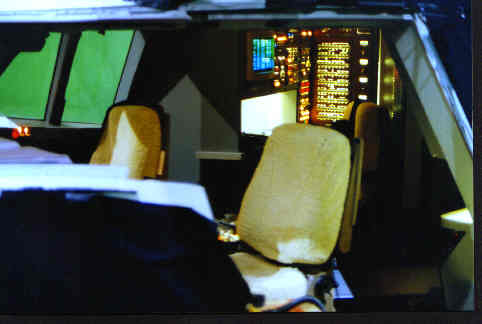
MISSION : IMPOSSIBLE 2 For : Paramount Pictures Art Director : Michelle Magahey Feb - June 1999 The very start of this film features a Boeing 747-400 which crashes into the side of a mountain. This production decided to build the relevant sections of the 747 first class cabin and also procured a 747 cockpit set borrowed from America - the one previously built for the film "Air Force One". So why we can't be fully credited for building the 747 cockpit itself, there was certainly a massive amount of work done to rebuild it suitable for this film. Fans of Tom Cruise will remember that he is an accomplished pilot. Artist Electronics were contracted specifically to handle all the electrics associated with the 747 cockpit and cabin. ArtElex also provided a number of other services for the electrical fitting out of other sets including location work at Bare Island and on the tunnel sets. The "Air Force One" cockpit as it arrived in Sydney was in poor condition. It required extensive rewiring and rebuild work. All of the main panels are backlit by 36w Biax tubes which had originally been wired for 115v conventional ballast operation in the USA, however MI:2 required these be totally replaced with electronically ballasted light sources suitable for 240v operation, which was a major part of the work task. Many of the indicator lights were requred to be practical, so they could easily be controlled from off camera. The three conventional aircraft instruments (two of which were broken and had to be replaced) were also modified to be practical. |
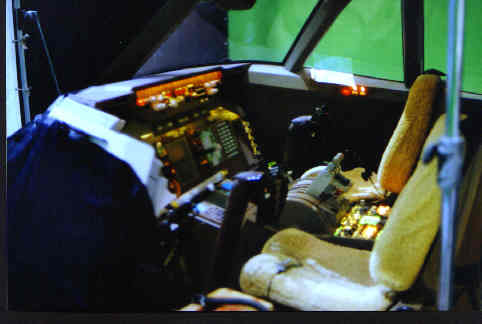
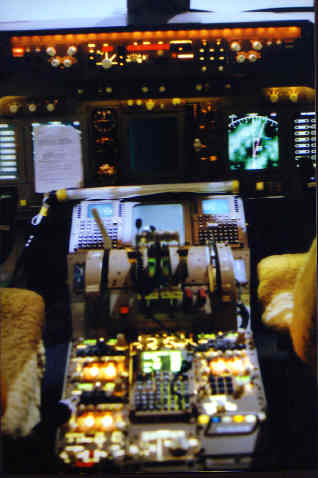
The original cockpit came with six LCD (Liquid Crystal Display) screens which had
been attached to mimic the real screens in a 747-400 aircraft. These came with
no data, no power supplies and no information on how they worked. Artist ELectronics
were required to research the manufacturer and obtain all the necessary
materials to enable them to be driven by 3 x MAC G3 computers which generated the
on screen graphics provided by the CGI dept. It actually turned out that three
of the displays were broken, and repairing them with no data or availability
of spares in Australia was no easy task. The Dashboard (note photo to left) contains the Autopilot display which was scripted as having a crucial role in the scenes to be shot in this set. Initially the designers had indicated that the data would be displayed on the two lower 6" LCD screens and that the counters on the Autopilot need not display anything other than fixed numbers. No materials came from the USA to drive them. However three days before the shoot, Tom finally got a chance to see it, and was greatly disturbed at why the designers had not even bothered to talk to one single pilot, let alone let us know that the autopilot counters did indeed need to work - and were in fact a hero prop. Artist Electronics designed, constructed and installed an electronics package to carry out the required task in only 48 hours - no mean feat, and probably the shortest time frame we have had for any electronic design project.. (and am likely ever to have). |
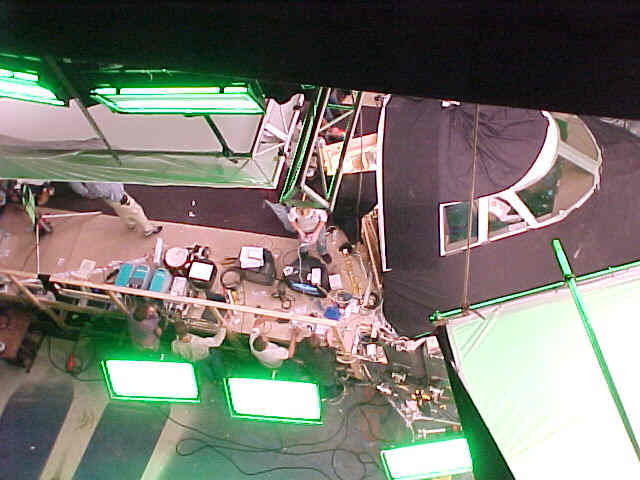
PHOTO RIGHT- An aerial view from the lighting grid of the 747-400 cockpit in use
for filming on Mission : Impossible 2. Below can be seen the three G3 Macs driving
the LCD screens inside, alongside the controls used to manipulate the other
displays in the cockpit. The green lights are lighting a Greenscreen that surrounds
the craft for digital Chroma Key effects. |

Left : A more general view of Fox Stage 2 during production of MI:2. In the foreground
can be seen the cockpit set whilst in the background the cabin set is readied.
This cabin set was eventually purchased by Fox and reused for a telemovie
"Nowhere to Land" in late 1999, who'se production company actually extended the
set and included a large Economy Class section to the rear. The complete set
(both the MI:2 and Nowhere to Land sections) are now housed at Homebush Bay and
are available to interested filmmakers. For MI:2, it was necessary to install over 150 "Kino Flo" 40w Flourescent tubes in the cabin set in very awkward places, and with allowance for the set to break apart easily as nobody knew what anybody wanted to do until the last minute. All the electrical work on this set was handled by Artist Electronics, both for MI:2 and later for "Nowhere to Land" at Homebush Bay. |
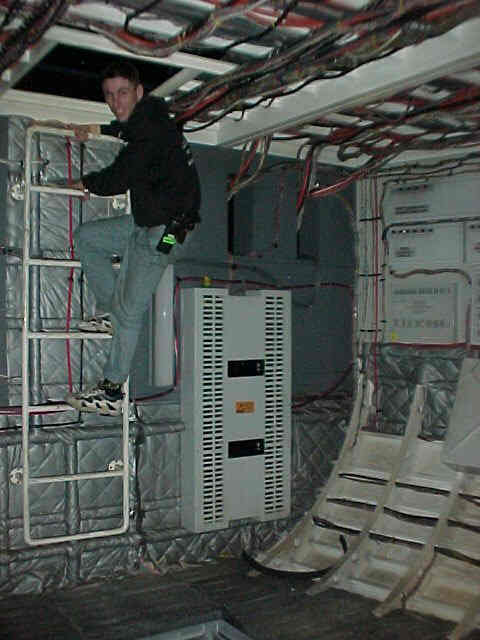
RIGHT : Artist Electronics staff member Andrew Goodman Jones inspects the MI:2 "747
Equipment Room Set", after completing installation of practical LED lights to
all the electronic props inside. This set was built above the large pit in Fox S2, so that the cast members could be shown dropping out from the belly of the plane at the start of the film. |